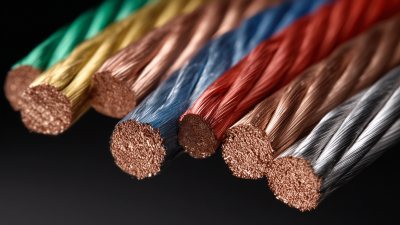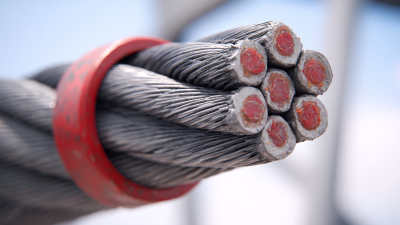In the welding industry, safety and efficiency are paramount, and one of the critical components that significantly impacts both is welding cable connectors. According to a report by the American Welding Society, approximately 20% of welding-related accidents are attributed to improper connections and equipment failure. This highlights the need for high-quality connectors that ensure reliable power transmission and minimize risks on the job site. Advanced welding cable connectors are designed to enhance safety by preventing overheating and ensuring secure connections, resulting in a more efficient workflow. As the global welding equipment market is projected to reach $25 billion by 2025, investing in the right welding cable connectors is not just a trend, but a necessary strategy for companies aiming to boost operational efficacy and compliance with safety standards.

When it comes to welding operations, selecting the right cable connectors is crucial for ensuring both safety and efficiency. With various types of welding cable connectors available, it is important to understand the specifications that best meet your operational needs. According to the American Welding Society (AWS), improper connector selection can lead to increased resistance, overheating, and even potential safety hazards. Therefore, focusing on factors such as amperage rating, materials, and environmental conditions can dramatically improve the performance of welding equipment.
There are several key types of welding cable connectors, including twist-lock, pin and sleeve, and quick-disconnect connectors. Twist-lock connectors are noted for their durability and secure connection, making them ideal for high-amperage applications. Meanwhile, pin and sleeve connectors can handle heavy-duty tasks and are often used in industrial environments due to their reliable sealing mechanisms. According to a recent report by IBISWorld, the welding equipment manufacturing industry has grown steadily, driven in part by advancements in connector technology, suggesting that investing in the right connectors also means keeping pace with industry developments for optimized operational efficiency.
When selecting welding cable connectors, key features are essential to ensure optimal performance and enhance operational safety. One significant aspect to consider is the material of the connectors. High-quality connectors made from durable, corrosion-resistant materials, such as copper or brass, not only ensure a secure electrical connection but also extend the lifespan of your equipment. The resistance to wear and tear is crucial, especially in environments where exposure to heat and chemicals is prevalent.
Another essential feature is the connector’s compatibility with different cable sizes and types. Connectors should provide a snug fit to prevent arc flashes and ensure maximum conductivity. Additionally, look for connectors with proper strain relief designs to minimize the risk of cable damage due to pulling or bending. Features like quick-disconnect mechanisms can enhance operational efficiency, allowing welders to switch out cables swiftly and safely, ultimately reducing downtime and boosting productivity in your welding operations.
When it comes to welding operations, prioritizing safety is paramount, especially when using welding cable connectors. One of the best practices is to regularly inspect these connectors for wear and damage. Over time, connectors can become corroded or develop loose connections, which poses a risk of electrical failure and increases the likelihood of accidents. By implementing a routine inspection schedule, operators can identify issues before they escalate, ensuring both the efficiency of their work and the safety of their personnel.

Another critical aspect of safe connector usage is the correct pairing of cables and connectors matched to the specific voltage and current requirements of your welding equipment. Using mismatched connectors can lead to overheating and electrical fires. Additionally, operators should always ensure that connectors are properly secured and free from moisture to prevent electrical shorts. Training staff on proper use and maintenance of welding cable connectors will further reinforce a culture of safety and efficiency within the workplace, minimizing the risk of incidents while maximizing productivity.
When it comes to welding operations, the integrity of your welding cable connections is crucial for both safety and efficiency. One often overlooked aspect of maintaining these connections is regular maintenance. Just as you wouldn’t ignore the upkeep of your welding machine, the connections that transmit power to your equipment also require attention. Regularly inspecting connectors for wear and ensuring they are clean and free from corrosion can help prevent electrical failures and enhance overall performance.
In addition to routine inspections, it's important to use the right kind of connectors suitable for your specific welding tasks. Over time, environmental factors can affect the performance of your connectors, leading to potential hazards. Keeping them protected with appropriate coverings and ensuring a snug fit is essential for preventing accidental disconnections. Maintaining the cleanliness of the connectors and using dielectric grease can significantly extend their lifespan, contributing positively to your workplace safety and operational efficiency. Investing time in maintaining these small yet vital components can lead to long-term benefits for both the quality of your work and the longevity of your equipment.

In the welding industry, enhancing productivity and efficiency is paramount, and one of the most significant factors contributing to these improvements is the quality of welding cable connectors. As the global laser welding machine market is projected to grow from $2.9 billion in 2025 to $4.5 billion by 2034, the demand for reliable connectors that can withstand rigorous environments is critical. High-quality connectors not only ensure safety but also minimize downtime, allowing for continuous operations and greater output.
Furthermore, the rise of IoT-based monitoring systems in manufacturing highlights the need for connectors that facilitate effective data transmission. As the amount of data captured during the welding process increases, the ability to leverage this information is vital for making informed decisions. The growth of the single-use bioprocessing connectors market, expected to increase at a CAGR of 15.77%, signifies a trend towards innovation in connectivity solutions. These advancements in connector technology are essential in meeting the demands for improved productivity and quality in welding operations.
| Connector Type | Material | Current Rating (Amps) | Voltage Rating (Volts) | Advantages |
|---|---|---|---|---|
| Twist Lock Connector | Copper Alloy | 300 | 600 | Secure connection, resistant to vibration |
| Electrode Holder | Insulated Plastic & Copper | 400 | 500 | Easy to handle, lightweight |
| Ground Clamp | Steel | 600 | 500 | Strong grip, reliable grounding |
| Quick Disconnect Connector | Aluminum | 200 | 600 | Rapid connections, reduces downtime |
| Insulated Connector | Copper & Plastic | 250 | 300 | Prevents short circuits, protective design |
| Straight Connector | Copper | 500 | 800 | High conductivity, durable |
| Dual Connector | Copper Alloy | 350 | 400 | Versatile, supports multiple connections |




